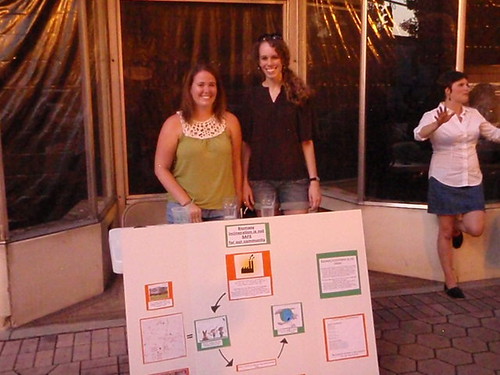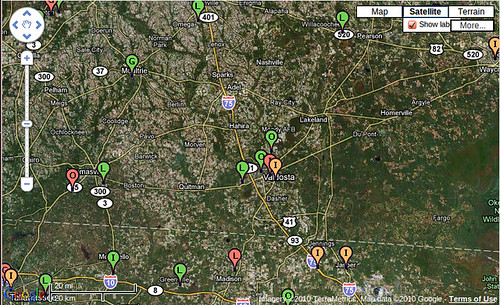Forest Tax Fairness: As a lead co-sponsor of legislation that would ensure property tax fairness for the owners of forest land, I am pleased to report that the House gave final approval to SB 409 last week and sent it to the governor for his signature.Unlike the VDT, Sen. Golden’s own website includes a link to the bill, SB 409, the “Georgia Forest Product Fairness Act” which reads in part: Continue readingThis bill, which passed unanimously in both the Senate and House, requires that any tax break or exemption granted to a business that uses “raw forest products,” such as a biomass energy plant, must also be granted to the owner of the property where that product is harvested.
This is good legislation for PCA and other manufacturers in our district, as well as the forest industry.
Category Archives: Biomass
Perspectives on Biomass Permit
Continue readingWhile certain entities see no negative environmental impact of the proposed biomass plant, the information and data that I have does not indicate that incineration of wood is efficient, environmentally sound, or safe for our citizens. Yet others see this as a win-win scenario claiming a vastly different perspective on the situation; economically, environmentally and in regard to the health of our citizens. Why is that?
EPA Call for Comments on Biomass Greenhouse Gas Emissions by Monday 13 Sep 2010
 Here’s the online EPA call cover page:
Here’s the online EPA call cover page:
On July 9, 2010, OAR Assistant Administrator Gina McCarthy signed a Call for Information in which EPA requests public comment and information from interested parties on approaches to accounting for greenhouse gas emissions from bioenergy and other biogenic sources.The EPA page provides several ways to send in comments.The purpose of this Call is to request comment on developing an approach for such emissions under the Prevention of Significant Deterioration (PSD) and Title V Programs (GHG Tailoring Rule) as well as to receive data submissions about these sources and their emissions, general technical comments on accounting for these emissions, and comments on the underlying science that should inform possible accounting approaches. GHG emissions from bioenergy and other biogenic sources are those generated during combustion or decomposition of biologically-based material, and include sources such as, but not limited to, utilization of forest or agricultural products for energy, wastewater treatment and livestock management facilities, landfills, and fermentation processes for ethanol production.
Also, Stop Spewing Carbon Campaign has prepared this handy link for submitting comments to the call.
See these links for much more about biomass, especially as proposed for Valdosta and Lowndes County, Georgia, and for carbon dioxide in particular. The air quality permit for the Wiregrass Power LLC biomass plant has no restrictions at all on CO2.
-jsq
Video of Biomass Air Quality Hearing, Valdosta, 27 April 2010
 A video of
a hearing about the biomass plant Wiregrass Power LLC proposes
to build in Lowndes County just outside of Valdosta was held
in Valdosta on 27 April 2010
by the Air Protection Branch (APD)
of the Environmental Protection Division (EPD) of the Georgia
Department of Natural Resources (DNR).
A video of
a hearing about the biomass plant Wiregrass Power LLC proposes
to build in Lowndes County just outside of Valdosta was held
in Valdosta on 27 April 2010
by the Air Protection Branch (APD)
of the Environmental Protection Division (EPD) of the Georgia
Department of Natural Resources (DNR).
Eric Cornwell of APD explains location, process flow, and specific items covered by the permit (soot, SO2, NOX, CO, VOC, HCL, etc., but not CO2). He remarks that Wiregrass Power LLC is building a small plant with a “lower emission limit in order to avoid some of the red tape” by getting a minor permit instead of a major permit. The first half hour concludes with Bob Turner, the plant manager, presenting similar material, ending with:
“No new carbon is added to the atmosphere when burning woody byproducts.”I beg to differ on that: in the time it takes trees to grow back, there is indeed new carbon dioxide added to the atmosphere. More from Dr. William Sammons on that.
Back to the video of the hearing. Questions start at 00:29:44. Here are some time markers and very brief summaries of Q and A; see the video for the full questions and answers. Continue reading
jsq VDT LTE pro Solar GA
-jsq
 Re: Forester R. Wayne Bell’s points of May 20, 2010. (Hi Wayne; I’ll get those dibbles back to you soon.)
Re: Forester R. Wayne Bell’s points of May 20, 2010. (Hi Wayne; I’ll get those dibbles back to you soon.)
Where does Georgia Power say Albany’s biomass plant will reduce carbon dioxide emissions by 95 percent? Biomass proponents usually say what Forester Bell says: trees are carbon neutral. That ignores the time gap between clearcutting and new growth. That gap from 15 to 100 years or more can produce a lot of CO2.
 As a tree farmer myself, I know the pulpwood market is down in Georgia due to the recession and foreign competition. I’d like to be convinced that biomass is the new market we need, but the more I look into it,
the more obfuscation I encounter.
As a tree farmer myself, I know the pulpwood market is down in Georgia due to the recession and foreign competition. I’d like to be convinced that biomass is the new market we need, but the more I look into it,
the more obfuscation I encounter.
Forester Bell seeks a study showing solar will work in Georgia. Georgia Power’s web pages (renewable energy -> solar -> solar potential)
http://www.georgiapower.com/spotlightsolar/solar_potential.asp
include a map of Georgia’s Solar Potential,
Continue reading
SAVE educates about biomass at First Friday
On the right, Natasha Fast is explaining it to somebody.
First Friday, Valdosta, Lowndes County, Georgia, 3 September 2010, Pictures and videos by Gretchen Quarterman.
-jsq
Where the biomass plants are
Who does know?
We are mapping all of the existing, proposed, closed and defeated dirty energy and waste facilities in the United States. We are building a network of community groups to fight the facilities and the corporations behind them.The detail map shown includes the Wiregrass Power LLC proposed plant (the orange oval I just south of Valdosta), two plants in Hamilton County, Florida Continue reading
Biomass plant air quality permit approved, but is that final?
 Georgia EPD approved the air quality permit for the Wiregrass Power LLC
biomass plant on Perimeter Road just outside Valdosta in Lowndes County,
with an effective date of July 19, 2010 (PDF, Word).
Somebody may want to do the exercise of comparing the approved permit
with the application to see if the process was entirely
rubberstamp or whether any changes at all were made after
the many questions
people asked at the
public hearing.
Georgia EPD approved the air quality permit for the Wiregrass Power LLC
biomass plant on Perimeter Road just outside Valdosta in Lowndes County,
with an effective date of July 19, 2010 (PDF, Word).
Somebody may want to do the exercise of comparing the approved permit
with the application to see if the process was entirely
rubberstamp or whether any changes at all were made after
the many questions
people asked at the
public hearing.
Meanwhile, is that it? Will the plant be built? Not necessarily: Continue reading
Water Planning
 In 2004 the state of Georgia adopted a water planning
system, and in 2008 adopted a water plan,
with regional councils appointed in 2009 by the governor,
lieutenant governor, and Speaker of the House.
While I wonder why this organizational setup inserted a regional
layer of government that is unaccountable to the people in the region,
it’s good somebody
is doing some water planning.
In 2004 the state of Georgia adopted a water planning
system, and in 2008 adopted a water plan,
with regional councils appointed in 2009 by the governor,
lieutenant governor, and Speaker of the House.
While I wonder why this organizational setup inserted a regional
layer of government that is unaccountable to the people in the region,
it’s good somebody
is doing some water planning.
In the event “gaps” between available water and future (or current) demands are identified, the Council will determine which water and land use management practices should be employed to ensure there is sufficient water and assimilative capacity to meet future needs. EPD will use computer models to test the ability of the recommended practices to close any identified “gaps.”If you remember Atlanta running out of water a few years ago Continue reading
Dr. William Sammons on Biomass Sustainability and Economics
 Here’s an interesting
video interview
with Dr. William Sammons,
the doctor who spoke in Traverse City just before that biomass plant was nixed.
Here’s an interesting
video interview
with Dr. William Sammons,
the doctor who spoke in Traverse City just before that biomass plant was nixed.
Is it more important to reach the target … or to say we have new information and we need to revise the targets and what qualifies?He’s talking about potential billions of dollars of health costs from particulates, about “waste” wood (what they say they will burn) vs. whole trees (what they end up burning), and most importantly about sustainability.
Biomass plants don’t have to report their CO2 emissions, so if all the proposed biomass plants get built we’re talking about as much as 800 million tons of CO2 from biomass plants by 2020, 12 to 14% of total CO2 emissions for the U.S. (not just power emissions: total national emissions). Trees don’t grow fast enough to suck all that back out of the air in ten years. Continue reading

